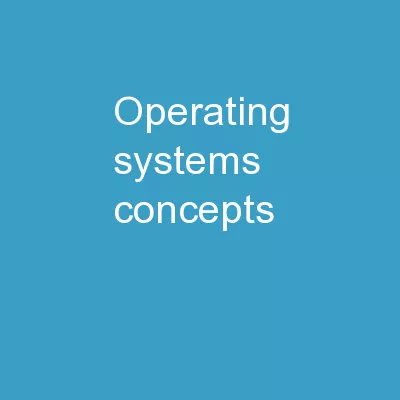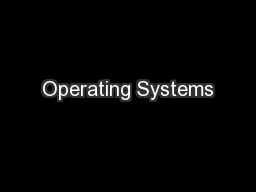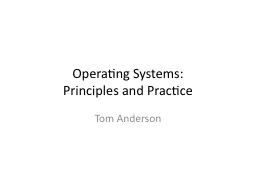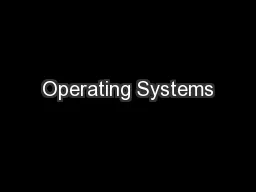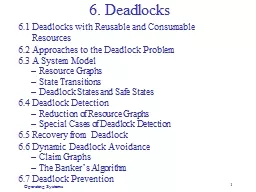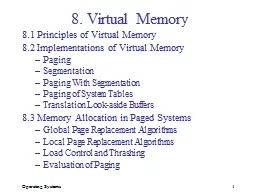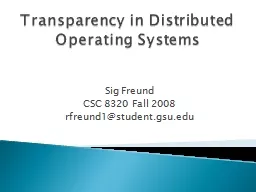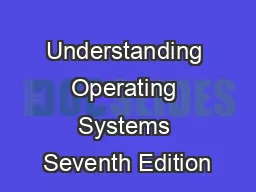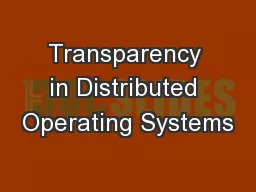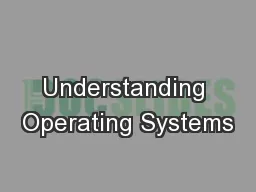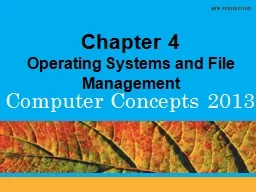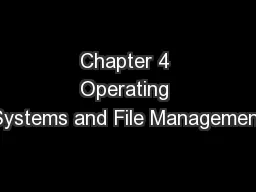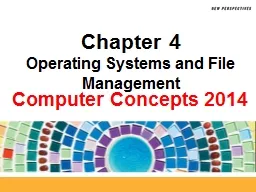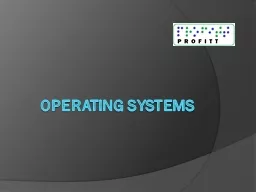PPT-Operating Systems Concepts
Author : trish-goza | Published Date : 2018-11-09
ltnumbergt A Computer Model An operating system has to deal with the fact that a computer is made up of a CPU random access memory RAM inputoutput IO devices and
Presentation Embed Code
Download Presentation
Download Presentation The PPT/PDF document "Operating Systems Concepts" is the property of its rightful owner. Permission is granted to download and print the materials on this website for personal, non-commercial use only, and to display it on your personal computer provided you do not modify the materials and that you retain all copyright notices contained in the materials. By downloading content from our website, you accept the terms of this agreement.
Operating Systems Concepts: Transcript
ltnumbergt A Computer Model An operating system has to deal with the fact that a computer is made up of a CPU random access memory RAM inputoutput IO devices and longterm storage ltnumbergt. 1. 11. I/O Systems. 11.1 Basic Issues in Device Management. 11.2 A Hierarchical Model. 11.3 I/O Devices. 11.4 Device Drivers. Memory-Mapped . vs. Explicit Device Interfaces . Programmed I/O with Polling . 1. 10. File Systems. 10.1 Basic Functions of File Management. 10.2 Hierarchical Model of a File System . 10.3 User’s View of Files. Logical File Organization. Operations on Files. 10.4 . File Directories. Principles and Practice. Tom Anderson. How This Course Fits in the UW CSE Curriculum. CSE 333: Systems Programming. Project experience in C/C++. How to use the operating system interface. CSE 451: Operating Systems. 1. 4. The OS Kernel. 4.1 Kernel Definitions and Objects. 4.2 Queue Structures. 4.3 Threads. 4.4 Implementing Processes and Threads. Process and Thread Descriptors. Implementing the Operations. 4.5 Implementing Synchronization and Communication Mechanisms. 1. 6. Deadlocks. 6.1 Deadlocks with Reusable and Consumable. . Resources. 6.2 Approaches to the Deadlock Problem . 6.3 A System Model . Resource Graphs . State Transitions. Deadlock States and Safe States . 1. 8. Virtual Memory. 8.1 Principles of Virtual Memory . 8.2 Implementations of Virtual Memory . Paging. Segmentation. Paging With Segmentation. Paging of System Tables. Translation Look-aside Buffers . Sig Freund. CSC 8320 Fall . 2008. rfreund1@student.gsu.edu. Transparency in Distributed Operating Systems. Evolution of Modern Operating Systems. Centralized operating system. +network access and resource sharing. Chapter 8. File Management. Understanding Operating Systems,7e. Learning Objectives. After completing this chapter, you should be able to describe:. The fundamentals of file management . File-naming conventions, including the role of extensions. Sig Freund. CSC 8320 Fall . 2008. rfreund1@student.gsu.edu. Transparency in Distributed Operating Systems. Evolution of Modern Operating Systems. Centralized operating system. network access and resource sharing. Seventh Edition. Chapter . 2. Memory . Management: . Simple Systems. Understanding Operating Systems, 7e. 2. Learning Objectives. After completing this chapter, you should be able to describe:. The basic functionality of the four memory allocation schemes presented in . Chapter Contents. Section A: Operating System Basics. Section B: Today’s Operating Systems. Section C: File Basics. Section D: File Management. Section E: Backup Security. Chapter 4: Operating Systems and File Management. Chapter Contents. Section A: Operating System Basics. Section B: Today’s Operating Systems. Section C: File Basics. Section D: File Management. Section E: Backup Security. Chapter 4: Operating Systems and File Management. Chapter Contents. Section A: Operating System Basics. Section B: Today’s Operating Systems. Section C: File Basics. Section D: File Management. Section E: Backup Security. Chapter 4: Operating Systems and File Management. Operating systems (OS) can help computer users do many things, like managing and manipulating files and folders.. Operating systems also provide users the ability to control hardware components of a computer and its peripheral devices, like printers and scanners..
Download Document
Here is the link to download the presentation.
"Operating Systems Concepts"The content belongs to its owner. You may download and print it for personal use, without modification, and keep all copyright notices. By downloading, you agree to these terms.
Related Documents

